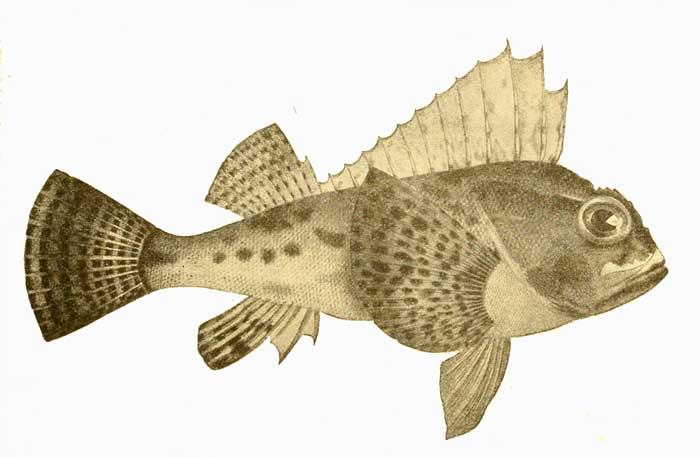
Superregnum: Eukaryota
Cladus: Unikonta
Cladus: Opisthokonta
Cladus: Holozoa
Regnum: Animalia
Subregnum: Eumetazoa
Cladus: Bilateria
Cladus: Nephrozoa
Superphylum: Deuterostomia
Phylum: Chordata
Subphylum: Vertebrata
Infraphylum: Gnathostomata
Megaclassis: Osteichthyes
Superclassis/Classis: Actinopterygii
Classis/Subclassis: Actinopteri
Subclassis/Infraclassis: Neopterygii
Infraclassis: Teleostei
Megacohors: Osteoglossocephalai
Supercohors: Clupeocephala
Cohors: Euteleosteomorpha
Subcohors: Neoteleostei
Infracohors: Eurypterygia
Sectio: Ctenosquamata
Subsectio: Acanthomorphata
Divisio/Superordo: Acanthopterygii
Ordo: Scorpaeniformes
Subordo: Scorpaenoidei
Familia: Neosebastidae
Genera: Maxillicosta - Neosebastes
References
Froese, R. and D. Pauly. Editors. 2006. FishBase, version (02/2006). [1]
Vernacular names
日本語: ヒレナガカサゴ科
Neosebastinae, the gurnard scorpionfishes or gurnard perches, is a small subfamily of deep-sea ray-finned fishes, it is part of the family Scorpaenidae. These fishes are found in the Indian and Pacific oceans. Several of the species in this family are venomous.
Taxonomy
Neosebastinae, or the family Neosebastidae, were first described as a taxon by the Japanese ichthyologist Kiyomatsu Matsubara in 1943.[1] The grouping is treated as a subfamily of the Scorpaenidae within the order Scorpaeniformes by the 5th Edition of Fishes of the World.[2] However, other authorities, such as FishBase, regard the taxon as a family within the suborder Scorpaenoidei, part of the Perciformes.[3] The family name is derived from the genus name Neosebastes which is a compound of neo meaning "new" and Sebastes, as, when he coined the name, Alphonse Guichenot thought that the new genus was closely related to or was a subgenus of the genus Sebastes.[4]
Genera
There are two genera which are classified in the Neosebastinae:[3]
Maxillicosta Whitley, 1935
Neosebastes Guichenot, 1867
Characteristics
Neosebastinae, the gurnard perches, have a prominent head with large eyes and a large mouth. There are strong bony ridges and spines on the head and cheeks. Much of the body and head are covered in rough ctenoid scales. They have 13 long and robust venom bearing spines in the dorsal fin and 6-8 soft rays.[5] They vary in size from a maximum total length of 50 cm (20 in) in the bighead gurnard perch (Neosebastes pandus) down to a maximum total length of 7 cm (2.8 in) in Whitley's gurnard perch (Maxillicosta whitleyi).[3]
Distribution, habitat and biology
Neosebastinae are found in the eastern Indian Ocean and the western Pacific Ocean where they have an antiequatorial distribution in temperate and subtropical waters either side of the equator. They are benthic fishes living on soft substrates and feed on small fishes and crustaceans.[5] They are oviparous, and, in at least N. pandus the females are larger than the males and the larger females have higher fecundity,[6]
References
Richard van der Laan; William N. Eschmeyer & Ronald Fricke (2014). "Family-group names of Recent fishes". Zootaxa. 3882 (2): 001–230. doi:10.11646/zootaxa.3882.1.1. PMID 25543675.
J. S. Nelson; T. C. Grande; M. V. H. Wilson (2016). Fishes of the World (5th ed.). Wiley. pp. 468–475. ISBN 978-1-118-34233-6.
Froese, Rainer, and Daniel Pauly, eds. (2021). "Neosebastidae" in FishBase. August 2021 version.
Christopher Scharpf & Kenneth J. Lazara, eds. (22 May 2021). "Order Perciformes (Part 8): Suborder Scorpaenoidei: Families Sebastidae, Setarchidae and Neosebastidae". The ETYFish Project Fish Name Etymology Database. Christopher Scharpf and Kenneth J. Lazara. Retrieved 2 January 2022.
Bray, D.J. (2018). "Gurnard Perches, Neosebastidae". Fishes of Australia. Museums Victoria. Retrieved 5 January 2022.
Peter G Coulson (2021). "The life history characteristics of Neosebastes pandus and the relationship between sexually dimorphic growth and reproductive strategy among Scorpaeniformes". Journal of Fish Biology. 98 (1): 50–63. doi:10.1111/jfb.14557. PMID 32978809. S2CID 221937710.
Retrieved from "http://en.wikipedia.org/"
All text is available under the terms of the GNU Free Documentation License

